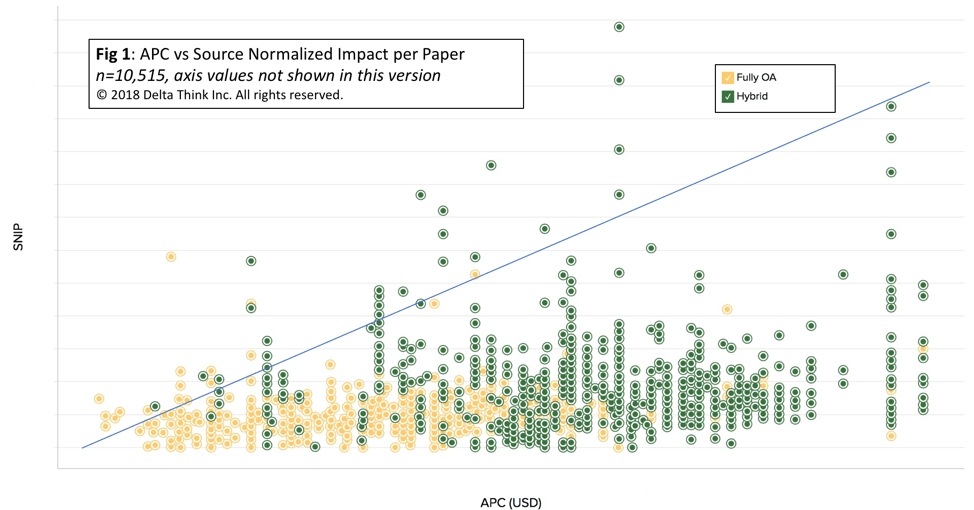Our latest survey of Article Processing Charges (APCs) shows a complex and immature market, with pricing set at random and not yet aligned with demand.
Over the last few years all the major publishers have added open access offerings to the bulk of their journals. Typically, existing journals are made hybrid by established publishers, in contrast with the fully OA portfolios of the newer publishers. The main money flow in open access boils down to levying APCs on individual accepted articles (self-archiving and sponsored models generate relatively little revenue). Whatever the nuance of payment flows (author or funder) and discounts, pricing patterns and drivers give a good read on how functional the marketplace is.
Impact Drives Author Decisions
A number of surveys have revealed that authors do not prioritize pricing when deciding to which journal they will submit their paper. Our survey and analysis of APCs confirms this, and reveals some interesting patterns – or lack thereof – behind pricing. The single strongest predictor of price is the journals’ business model: hybrid is more expensive, fully open access is least. However, there the patterns end.
There is little relationship between impact and price, with some of the most expensive APCs being levied for journals with relatively modest impact metrics. Figure 1 shows this in practice, comparing price with impact for 10,000 journals across all subject areas. We use the field-neutral Source Normalized Impact per Paper (SNIP) as a proxy for the Impact Factor and would expect the spread of dots to follow the blue diagonal shown if there was a strong relationship between the two measures.

This is one chart of several visualizations in our study, but all show a similar random pattern, with the exception of some shifts within particular subject areas (such as some of the social and physical sciences).
Comparing Value
Another method for evaluating market function is to review competitive positioning within the APC landscape. If we compare the average impact of publishers’ journals with their average prices, we derive a loose definition of “positioning.” This demonstrates how publishers sit relative to one another by looking at their average “bang vs. buck” – as visualized by plotting average impact per journal against average APC illustrated in Figure 2.
There is one bubble per publisher in our sample (size is proportional to the number of journals published). Our full tool shows axis values and all publisher names, including those for the fully OA data, but we have extracted just a few in Figure 2 as a sample. Bottom right is “better” (high impact, low price); top left is “worse” (low impact, high price).

We would expect the bubbles to follow the diagonals (lower diagonal for fully OA, upper one for hybrid) if there was a strong relationship at work, i.e. the market was making choices based on “impact” and publishers were matching prices to meet this demand. While fully OA spread is showing some signs of this, it seems that hybrid pricing is the opposite, suggesting publishers are making deliberate choices driven by other factors.
Conclusion
Our data suggest a random spread of pricing and mild price decreases since last year. There are outliers of course. Hybrid prices are more expensive on average, but the most expensive APC is levied for a fully OA journal. Average prices have fallen overall, but some disciplines see notable price increases. However, with over 13,000 prices mapped to over 10,000 indexed entries across over 300 subject areas, our sample is still representative. Maximum, minimum, and average pricing varies by publisher, by discipline, and by business model. Our analytics tool makes these drill-downs accessible. The data presented here offers a taste of the patterns that can be surfaced.
Looking forward, open access represents a shift to a demand-side model, so we would expect pricing patterns to shift…IF the market was exercising choices based on price! With no discernible factor(s) currently driving price, it seems there is potential for publishers to consciously optimise prices to match demand.
And with demand in this market apparently driven solely by perceptions of quality, with authors seemingly blind to price points, publishers may choose to optimize price based on Impact Factor and/or a strong brand. In fact, in such a marketplace, a 5-figure APC is potentially achievable for a top flight journal. Put another way, would an OA-advocate funder pay $10,000 or even $25,000 to have the results of their multi-million dollar project published in Nature or Science? They might.
Given the supplier-driven nature of the market, it’s perhaps not as crazy as it sounded a few years ago.
Editor: Ann Michael
![]()
The Article Processing Charges (APC) section has been updated and expanded. The update shows list prices as of early 2018. Several new sections have been added to provide a more comprehensive overview of pricing patterns and drivers.
- As ever, the executive summary distills our data and analysis into some key takeaways.
- Visualizations and data from over 14,000 journals offer an overview of the market, typical prices, what is cheap or expensive, and how publishers spread their prices across their portfolios.
- The relationships between price and impact show patterns by subject and show how the major publishers compare.
- New visualizations examine the relationship between price and journal size, and show how prices have changed over time.
- Tables have been added to show at-a-glance summaries of averages.
Additionally, the Publisher section in our Market Dynamics coverage now includes analysis of proportions of fully OA, hybrid, and non-OA journals for major publishers.
![]()
TOP HEADLINES
Hybrid journals vital for extending author choice, research shows – February 28, 2018
“Hybrid journals play an important role in extending author choice, a report by the Publishing Research Consortium, Research Consulting and Pleiade Management & Consultancy has shown. The report aims to understand authors’ motivations when selecting to publish in Hybrid Open Access journals.”
Update to Analysis of Open Data Policies finds new activity around OA and OD policies in multiple countries – February 28, 2018
“SPARC Europe, together with the Digital Curation Centre (DCC), recently released an update to their analysis of Open Data policies in Europe. This latest version has been updated to reflect Open Data policy changes that have surfaced between June and November 2017, and encompasses the 28 EU member states as well as several non-EU members of the European Research Area.”
HRB Open Research publishes first articles – February 28, 2018
“HRB Open Research launches with 8 articles covering topics from mental health to cervical screening. A wide range of article types are also represented from more traditional Research Articles to Study Protocols.”
Copyright Clearance Center Launches New OA Agreement Manager to Automate and Streamline Funding of APCs – February 27, 2018
“Copyright Clearance Center, Inc. (CCC) recently launched the OA Agreement Manager, the first integrated publishing workflow solution to help eliminate the cost and friction from processing funded open access (OA) articles for all stakeholders.”
Opening up the research lifecycle: Taylor & Francis introduces new data sharing policies – February 13, 2018
“Taylor & Francis introduced a suite of new data sharing policies to drive open scholarship forward and help the research communities they work with achieve their goals. A basic policy encouraging data sharing will be applied to all titles owned by Taylor & Francis, with an aim to move many journals to more progressive data sharing policies during 2018.”
American Society for Microbiology joins the Initiative for Open Citations – February 12, 2018
“The American Society for Microbiology has joined the Initiative for Open Citations (I4OC). I4OC is a collaboration between scholarly publishers, researchers, and other interested parties to promote the unrestricted availability of scholarly citation data.”
Wiley, the Austrian Academic Library Consortium (KEMÖ) and the Austrian Science Fund (FWF) Announce Combined Open Access and Subscription Agreement – February 12, 2018
“This transformative agreement will provide researchers and students at 22 institutions affiliated with KEMÖ access to all subscription journals published by Wiley. Corresponding authors from KEMÖ-affiliated institutions will also be able to publish unlimited open access articles in Wiley’s hybrid journals at no charge to the author.”
eLife joins the Neuroscience Peer Review Consortium – February 9, 2018
“As eLife receives a substantial number of submissions on neuroscience topics, the organization has joined the Neuroscience Peer Review Consortium (NPRC), a cross-publisher alliance of journals which aims to reduce the time and effort involved in the peer review and publication of original neuroscience research.”
Earth And Space Science Open Archive (ESSOAr) Beta Preprint Server Open For Submissions – February 8, 2018
“Powered by Atypon and supported by AGU, the community server is now accepting submissions including manuscripts and posters from scientific conferences.”
PubMed Commons to be Discontinued – February 1, 2018
“PubMed Commons has been a valuable experiment in supporting discussion of published scientific literature. The service was first introduced as a pilot project in the fall of 2013 and was reviewed in 2015. NIH has decided that the low level of participation does not warrant continued investment in the project, particularly given the availability of other commenting venues.”
OA JOURNAL LAUNCHES
March 1, 2018 | “SPIE, the international society for optics and photonics, and Chinese Laser Press (CLP), have entered into a partnership for a new journal, Advanced Photonics. This will be a highly selective, open access, international journal, publishing innovative fundamental and applied research in optics, photonics, and related fields.” | |
February 27, 2018 | “IOP Publishing has launched three new, high-impact open access journals. In recognition of the increasingly interdisciplinary nature of research, the scope of these new journals will focus on research covering three aspects of the physical world that will shape the future of our planet: energy, materials and light.” | |
February 21, 2018 | “John Wiley and Sons Inc., in partnership with the Federation of American Societies for Experimental Biology (FASEB), is pleased to announce a new peer-reviewed, open access journal, FASEB BioAdvances.” | |
February 7, 2018 | “Frontiers in Immunology is delighted to announce the launch of its latest section, Autoimmune and Autoinflammatory Disorders. The new section aims to address key challenges facing the field, notably by providing a scholarly resource that can help practitioners bring novel autoimmune and autoinflammatory findings into clinical practice.” | |
February 6, 2018 | “The British Institute of Radiology (BIR) announced the launch of a new international, fully open access, online journal. BJR|Open will publish papers across the whole of the radiological sciences, including radiology, radiation oncology, radiobiology, medical physics, nuclear medicine and all allied areas.” |

